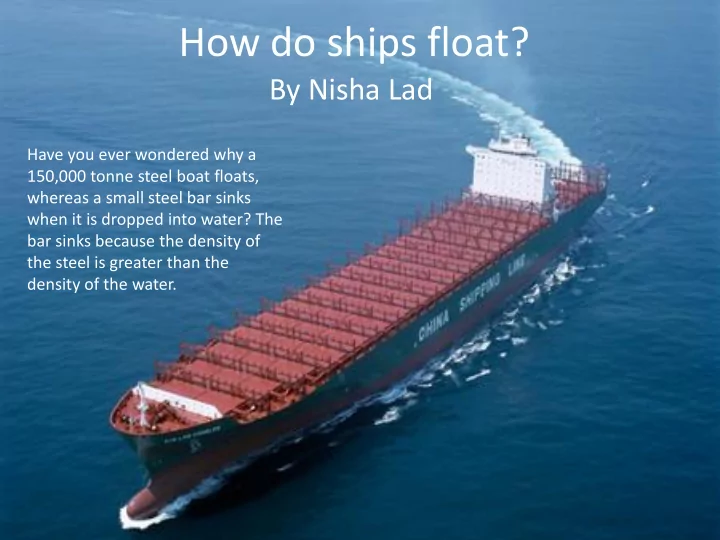

How do ships float? By Nisha Lad Have you ever wondered why a 150,000 tonne steel boat floats, whereas a small steel bar sinks when it is dropped into water? The bar sinks because the density of the steel is greater than the density of the water.
This is similar to when oil is mixed with water – the oil droplets form on the surface as they are less dense compared with water. But then how does that answer the question as to how cargo ships and ocean liners float, when they are made of steel and thousands of times larger than a steel bar. Well, consider Buoyancy, average density and Archimedes principle.
Firstly, consider buoyant force (or up thrust), which is the opposing force to gravity and acts upwards. To understand this, think of an ice cube in a glass of water. As the ice cube displaces some of the water, it causes the level in the glass to rise and the ice cube to float partially in and out of the water. This is because gravity is pulling the ice cube down and buoyant force is pushing it up. How far in or out of the water your ice cube rests depends upon on its density. The amount of water the ice cube displaces is equal to the weight of the ice cube immersed in the fluid.
This is Archimedes principle. An object in a fluid experiences an upward force equal to the weight of the fluid displaced by the object. So if a boat weighs 1,000 kilograms, it will sink into the water until it has displaced 1,000 kilograms of water. Provided that the boat displaces 1,000 kilos of water before the whole thing is submerged, then the boat floats.
So back to our question: The ability of a boat to float depends on its average density. Average density takes into account not just the weight of the steel hull but also the air trapped in it. A ship with a large volume of trapped air has a lower density than that of the water – so it floats. This principle is vital in transporting goods overseas today, as cargo ships that transport heavy loads use especially long and wide hull construction to increase the maximum amount of buoyant force. As the larger the hull, the more trapped air the ship has, and therefore the more buoyancy and it less dense than water, so it floats.
Archimedes principle has many applications. Hot air balloons use this principle in the way that when air is heated, hot air is less dense than cold air due to thermal expansion, and so the balloon will rise.
Also with submarines; in order for it to sink the crew must pump water into the ballast tanks, resulting in the submarine becoming denser than the surrounding water. Archimedes Principle is also used to determine how much cargo you can put on a ship without it being fully immersed in water. So in conclusion: By Archimedes principal every object when immersed in water will displace an amount equal to its own weight. Also, in the case of the ship, due to the large amount of air pockets on the ship and wide hull construction, there is a large buoyant force created, and provided the object has displaced its own weight of water before becoming fully immersed, it will float.
Recommend
More recommend